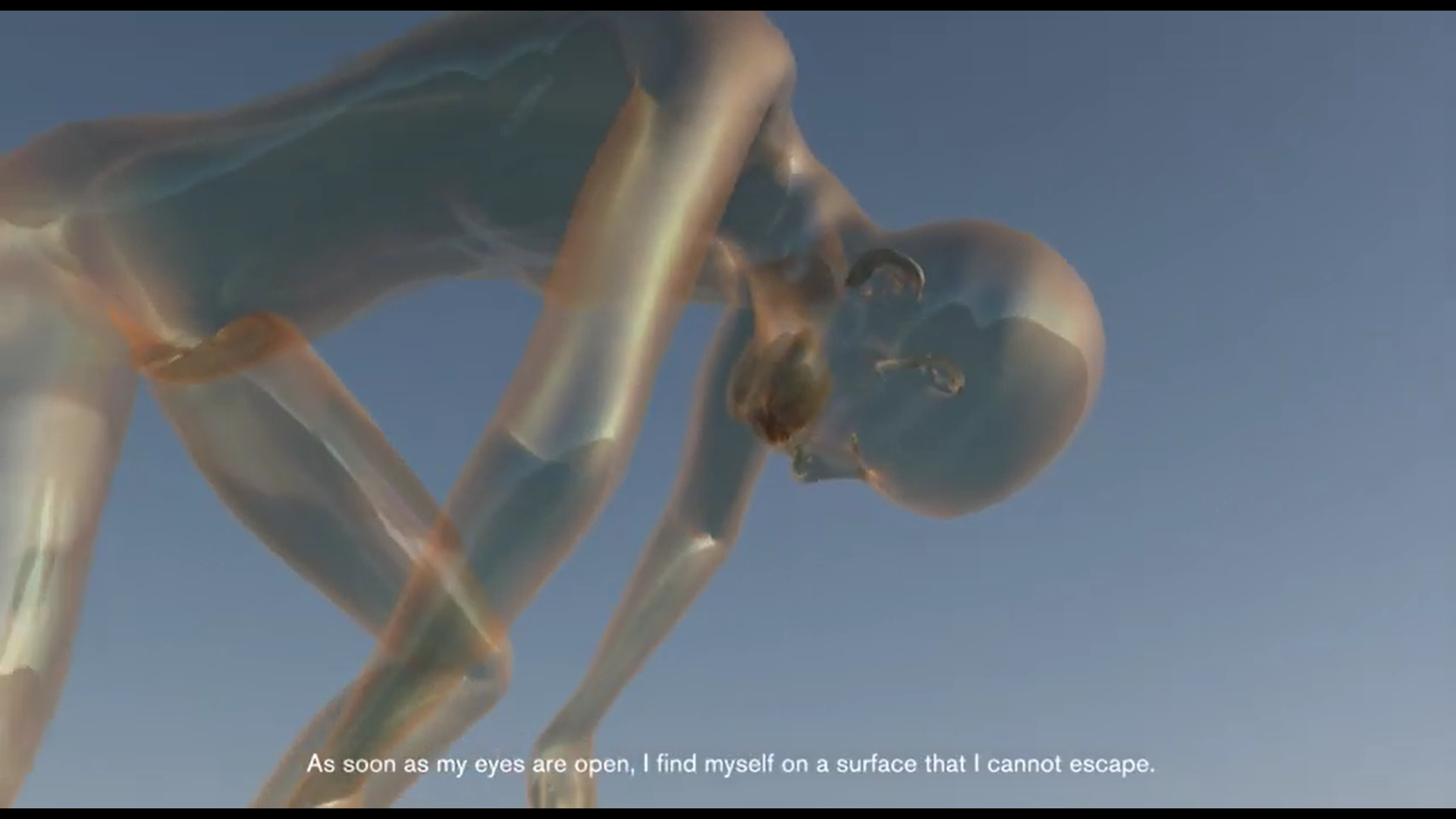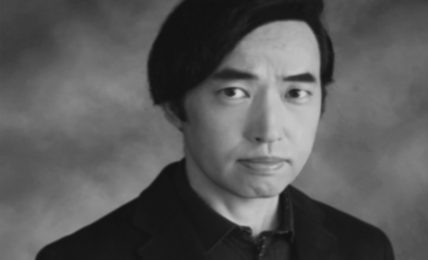Ana Jovanovska is a Macedonian artist who explores social structures and the influences of pop culture. In her piece When you think about painting do you think about something like this? (2018), Jovanovska unpacks the associations that often accompany “high” and “low” forms of art.
:::
DigA: Cartoons are designed to be accessible forms of entertainment in our popular culture, where they’re often mislabeled “low art.” In your piece When you think about painting do you think about something like this? you repurpose “low art” into a contemporary piece. How do you see “low art” and contemporary art held in conversation? Is accessibility—in all permutations—important to your work?
Ana Jovanovska: Accessibility is very important to my work. Motivating and presenting critical thinking is also very important.
There is a visible differentiation between the two, but I feel like there is a problem with the “high/low art” (that was fine art/craft before) distinction and the way it implies value and reinforces established stereotypical groupings that do not work anymore in contemporary art. This notion of art being either solely functional (“low art”) or solely an aesthetic contemplation (“high art”) is a problematic classification. That means all crafts are low art… and all movies?
The contemporary art concept needs diversity, and is, or should be, activist at its core (has an idea behind it, a cause, a purpose), therefore the contemporary “high art” is actually, in a way—low art?
There would be no “high art” video work like When you think about painting do you think about something like this? if there were no “low art” cartoons to inspire it.
DigA: Artists and institutions often use “art speak” to describe their pieces. Although this language might elevate artists’ works and describe complex ideas, it often brings the understanding of a piece beyond the reach of the average viewer. (At the very least beyond the fifth-grade reading level that writers from journalists to museum interpretation teams strive to achieve.) Did you have “art speak” and inaccessibility in mind when you created When you think about painting do you think about something like this?
AJ: Yes, I did have this rather elitist attitude in writing, presenting and describing art by, mainly, art professionals in mind. This approach in communication of the artist (or gallery representing the artist) with the viewer of his/her artwork, makes it seem as though the description of the artwork was meant to be understood by, primarily, others working in the field. As if the best of art equates with the obscurest of words in describing it. As if to show “Hey, fellow artists, I’ve got that expensive degree too.”
Having said this, I too, tend to describe my concepts with many professional art terms and “art speak,” since this is the accepted, but also most constructive way of discussing ideas among colleagues.
At the same time, I also disagree with the pervasive viewpoint distribution of mass media portraying contemporary art as nonsense in work and in words.
DigA: When viewing this piece, we couldn’t help thinking about the cartoonists themselves as a layer to the work. How does the role and work of the cartoonist influence the piece?
AJ: I created this work as a type of research piece on pop culture’s position on contemporary art (often mockingly, less often – enthusiastically, more often they just express total confusion about it all). I was fearful that the video work would be seen by some as appropriating somebody else’s work as my own or exploiting it for my own agenda. That’s why, in trying to remain fair and legitimate, I added a disclaimer and collected a pile of documents of international law, European law and Macedonian law on the subject in the process.
DigA: What was your process in creating When you think about painting do you think about something like this? Was this a process that you’ve explored in your other work?
AJ: The full video installation was created for the Biennial of Young Artists exhibition selection at the Museum of Contemporary Art in Skopje in 2018. I had already started collecting material from the web some time before that and it seemed like the perfect opportunity to present this new work there. The process involved a lot of screen time and hours and hours of watching cartoons online. Some were not available in my region, so I had to think of other ways to watch them. Some inserts were easy to find and I cut the part needed for the video collage just searching by keywords. For others, I had to dig through abandoned forums for days. When I gathered sufficient video material to select from, I started with cutting and ordering them into the video editing program. I wanted to make the video collage feel like it has a beginning and an ending, therefore I strategically cut a snippet into two, a part with a “question” placed at the beginning and the other with an “answer” at the end of the collage.
When referring to the full video installation for the purposes of the exhibition, the video was played on a loop in a simulated living room in the gallery space, with all the necessary items: a sofa with pillows, carpet, house plants, TV, a framed reproduction of the Mona Lisa painting, a coffee table and a bowl of free popcorn for the audience.
This year in May, the video will be playing as a solo show, part of the Kitchen Sink Project in the actual living space—the kitchen of the co-curators Naomi Even-Aberle & Nik Aberle. So, I am excited to see how the work will be read in the context of a real household environment.
There is one similar video collage, that I have made previously, called Blah Blah Bla on the meaning of language.
I like to work in all mediums, from drawing, painting and printmaking through sound and moving image to research, writing and mapping. My projects are idea-based, i.e. the idea determines the medium of the work at hand.
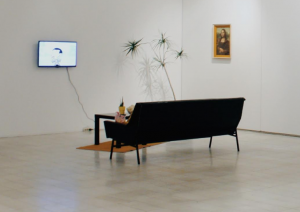
DigA: From Us to Mirrors, we see themes of society shaping human behavior, and, in turn, the way humans affect other beings and their surroundings. In Us, you use collage and transparent paper to question the stripping humanity from its social constructs. Meanwhile, in Mirrors, an interactive piece, you make pictures of the neglected parts of Kumanovo, North Macedonia, available for editing to create a before and after of human impact on the city. Can you talk about the broader themes of your work and the role of exposing the often-salient insights of pop culture to reflect on itself?
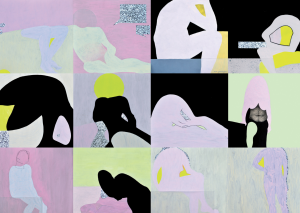
AJ: As you noticed from my body of work, I gravitate toward exploring or depicting themes that have a social element and impact, presenting it through art that mirrors back the reality of today’s society. Consequently, I am interested in exploring how perspectives work with human conditioning starting from the communication of an idea, debating the structure of society is in many ways conditioned by the structure of language itself.
My practice appears to be rooted in deep observation and reaction to the current times and spaces, affected by the moralizing of traditions and a sense of urgency in the discourse of contemporaneity. Hence, I am interested in research-based in creative rethinking, reimagining and retelling a narrative.
Check out Ana Jovanovska’s When you think about painting do you think about something like this?
:::
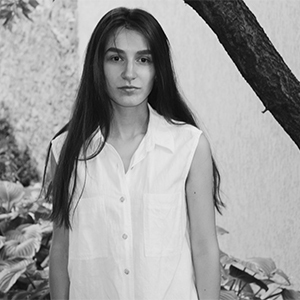 Ana Jovanovska received her BFA in Graphic Arts and Graphic Design from the Faculty of Fine Arts- Skopje – University St Cyril and Methodius, Macedonia, 2014. Upon receiving a scholarship for a semester she attended École supérieure d’arts & médias de Caen/Cherbourg in France, 2013-2014. She got her MFA in the Graphic Art Field from the Faculty of Fine ArtsSkopje – University St Cyril and Methodius, Macedonia, 2016. Ana had 9 independent and more than 150 group exhibitions in Macedonia and many countries abroad.
Ana Jovanovska received her BFA in Graphic Arts and Graphic Design from the Faculty of Fine Arts- Skopje – University St Cyril and Methodius, Macedonia, 2014. Upon receiving a scholarship for a semester she attended École supérieure d’arts & médias de Caen/Cherbourg in France, 2013-2014. She got her MFA in the Graphic Art Field from the Faculty of Fine ArtsSkopje – University St Cyril and Methodius, Macedonia, 2016. Ana had 9 independent and more than 150 group exhibitions in Macedonia and many countries abroad.

